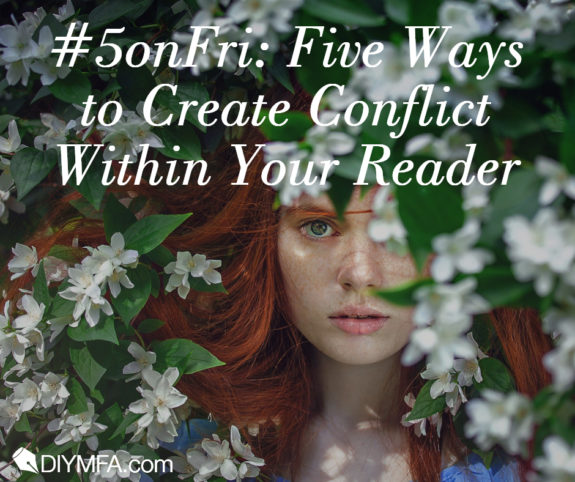The man-versus-X distinctions we were taught in school are pretty useless. In my experience, at least, knowing that an individual might struggle against nature or man or self or society does little to help me craft gripping scenes.
Don’t get me wrong: I’m not saying conflict isn’t important. It’s absolutely essential. But giving broad labels to the types of conflicts a character may face does little to help a writer understand the utility of conflict to a story.
And what is that utility? Well, there’s what conflict means for a character and what it means for a reader. For the character, conflict is the catalyst for character transformation—be it a small change or a large one. But I’d argue that the conflict that really matters is the one the reader experiences subjectively.
Writers need to examine conflicts for their effect on readers even more than for their effects on the characters within the stories. So, I present five situations writers can craft in order to create conflict within the reader.
1) Classic Conflict
I like James Scott Bell’s definition of conflict: “a clash between at least two incompatible sides,” one of which “must be personal, that is, having the ability to exercise conscious will.”
Examples abound, of course. Katniss battles the other tributes, Harry battles Voldemort, Elizabeth Bennett argues with Darcy. Climax scenes usually fall back on this most tried and true method of engaging readers, but you’ll find smaller conflicts throughout every story.
Readers observe the conflict, uncertain about the outcome. Will the character we’re watching “exercise his will” to triumph or lose? Our minds mirror the conflict in the story as we can see the outcome going either way. It’s that uncertainty, that conflict within readers, which keeps them reading.
2) Threat
But you don’t need actual conflict to occur to the character in order to create that uncertainty within readers. You can create threat, which is the potential for conflict or trouble.
For example, have a protagonist navigate a menacing setting on the way to a destination. Fill it with darkness or shadows or creepy-crawlies or some other ultimately harmless atmospherics and you’ll have readers worrying.
It’s not even necessary that the character worries. You know all those scenes in horror stories that have characters innocently going to the basement for some menial errand? Those characters need not worry. Nor is it necessary that they encounter a murderer in the basement.
It’s enough just to have the readers crawling out of their skin.
3) Mystery
Threat brings up a very important concept: that the reader may have a different understanding of story events than the characters. Writers can capitalize on that concept by creating mystery.
Mystery occurs when the reader knows less than the characters. And in an effort to make sense of the mysteries presented them, readers experience a small struggle to synthesize the new information.
Thus, when we read that “The drone arrived at 11:00 with the red box,” we formulate some nascent theories about the world and the plot of the story, theories that are then put to the test, challenged, and revised as we continue reading.
Story beginnings are particularly well-suited to mystery. We often don’t know enough about the context or the characters to be engaged in the outcome of a classic conflict in the first paragraphs of a story. But mystery is like a toddler tugging at our sleeves for attention. Take, for example, the first line of Madeline Miller’s Circe: “When I was born, the name for what I was did not exist.”
4) Surprise
Any time readers meet with the unexpected, they experience surprise. That unexpected revelation may or may not be a conflict for the character. It is in the case of Luke finding out that Darth Vader is his father.
But heist stories, for instance, (like Oceans 11—or 12 or 13 or 8) often have revelations about what clever mechanism or behind-the-scenes plot got the heroes to their current success.
Such revelations are not conflicts for the characters. But they create conflict as the reader has to re-evaluate assumptions. The ending of Carmen Maria Machado’s short story “The Husband Stitch” has exactly that effect on readers. The final revelation is not a surprise for the protagonist, but it forces the reader to grapple with the new understanding.
5) Expectation
We can think in broad terms about how reader anticipation provokes a sort of conflict: a prediction is formulated and then tested, challenged. Threat is a form of negative anticipation, in which readers predict problems. But readers can feel some subjective conflict from an opposite, positive anticipation.
We’ll call it expectation: when we predict success or good fortune for the character.
The protagonist meets a very cute romantic interest, for example. They hit it off. No clash, no conflict. Eventually, sure, there may be complications in the romance plot. But even at the first uncomplicated meeting, the reader experiences that subjective conflict in daring to hope.
Any time change is possible for characters, readers will feel tension in weighing what that change might mean.
So there you go. Five ways for writers to make the most of conflict in stories. Not all of them portray conflict experienced by the characters. But all five create conflict for the reader. And that’s what we’re after.
 T.D. Storm is an award-winning writer and teacher whose work has appeared in a number of journals and anthologies, including Black Warrior Review, Copper Nickel, and Literary Hub. His passion for storytelling and its inner workings informs his teaching, editing, and mentoring. He runs an online writing school (stormwritingschool.com), which offers articles, worksheets, and courses geared toward helping writers hone their craft of engaging and moving stories. You can also connect with him on Facebook and Pinterest.
T.D. Storm is an award-winning writer and teacher whose work has appeared in a number of journals and anthologies, including Black Warrior Review, Copper Nickel, and Literary Hub. His passion for storytelling and its inner workings informs his teaching, editing, and mentoring. He runs an online writing school (stormwritingschool.com), which offers articles, worksheets, and courses geared toward helping writers hone their craft of engaging and moving stories. You can also connect with him on Facebook and Pinterest.







